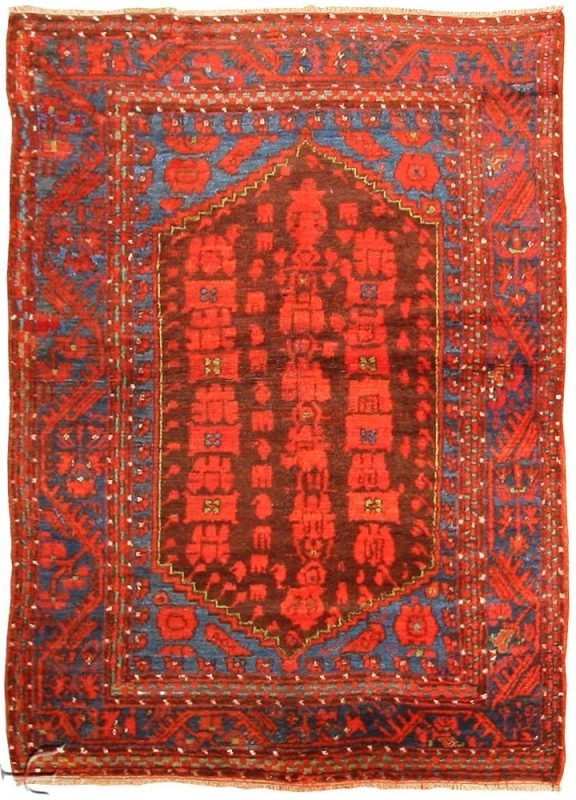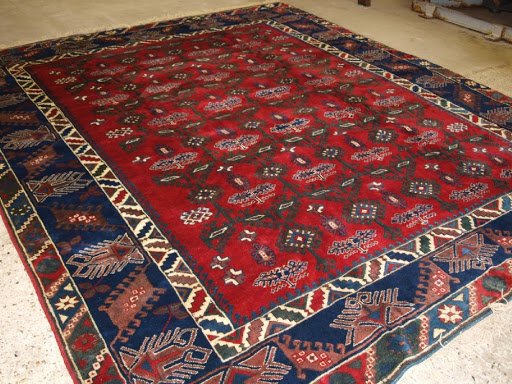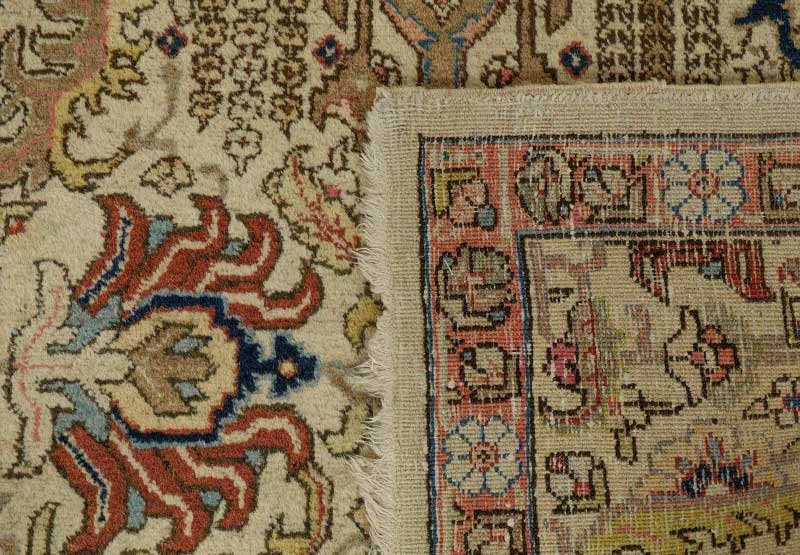Antique Turkish Carpets
One of the common types of artistic craft was carpet weaving. Another famous Arab traveler, Ibn Battuta, who visited Asia Minor in the 30s. of the XIV century admired the carpets from Aksaray and noted that they are famous throughout the East. Researchers believe that high-quality wool carpets were made not only in this city, but also in Konya and Sivas.
Turks believe that they were the first to invent a fleecy knotted carpet. However, they are only the heirs of the long-standing beautiful tradition of textile production, dating back to the nomadic tribes of Central Asia, where the first of the famous carpets were found. In addition, the Turks who came to Anatolia with their herds of sheep and goats discovered a centuries-old tradition of carpet weaving there.

For example, it is believed that the frescoes in the Hittite ancient settlement Chatal-Hyuk (c. 6500-5300 BC) reproduce kilim carpet, i.e. lint-free carpets and carpet paths. In Gordion, many weights from a loom in the form of pebbles were found; in addition, the pattern of the local mosaic floors is extremely similar to textile ornaments.
The ancient art of carpet weaving in Turkey has been passed down from generation to generation.
In Turkey, both antique, rather expensive carpets are sold, as well as new ones made in ancient technique and style. Carpets are handmade or machine made. If, by bending the carpet, you will take away the knots on the back side, and the pile cannot be pulled out, then the carpet is handmade.
The oldest carpets in Turkey can be seen in the Museum of Turkish and Islamic Art in Istanbul, as well as in the Konya Museum. These are rude but powerfully ornamented Seljuk rugs dating from the 13th century, discovered at the beginning of this century in the Seljuk capital Konya and the nearby city of Beysehir. The Istanbul Museum also exhibited samples of Turkish carpet weaving of various styles and patterns. Ornaments are very diverse: from geometric figures to arabesques, which are found on some carpets from the Sultan’s palace, woven in the workshops of Istanbul and Bursa. This tradition was inherited by silk and wool carpets from Hereke, where a court factory was founded in 1891.

Continuing the tradition of Ottoman court carpet weaving, today carpets in Herek are also woven according to special designs representing the mechanical connection of various styles. Girls working in the factory are able to work miracles, for example, tie 30 knots per minute. A significant part of the oldest carpets exhibited in museums in Istanbul is woven in Western Turkey, in the region of Usak.
Until now, the city of Kula is an important center for their production, although the modern carpets there are little similar to their predecessors and weave in pastel colors according to Caucasian patterns for the foreign market.
In contrast, ancient Turkish carpets have an individual palette, including rich purple, sparkling yellow and bright green colors in addition to the usual shades of red and blue.

Antique rugs with geometric patterns in red and blue are now matched with rugs from Bergama and Yagdzhibedir. Starting in XIV, Turkish carpets were apparently exported in large quantities to Europe. Quite a lot of them can be seen in European churches and in paintings, which are an important source of information about Turkish carpets of the XIV-XVII centuries. The English king Henry VIII, having started buying them, could no longer stop. He posed for Holbein on the Turkish rug and was happy to take possession of the large collection of carpets of his favorite Cardinal Walsi when he fell out of favor. Although the inventories of the time indicate that approximately half of his 800 carpets were Turkish, but, like many subsequent collectors, the king did not care about his carpets, and they all rotted on the damp stones of the royal palace in Hampton Court.
Many ancient Turkish carpets have survived to the present thanks to the custom of donating carpets to mosques. The floors of mosques are still a showcase of local carpet weaving. The folk tradition of carpet weaving existed side by side with exquisite production in court and city workshops. Until the present century, in most houses I had looms, from which weaved carpets and rugs, all kinds of bags, and also shawls and other items of clothing. The threads for these home looms were hand-woven on spindles or spinning wheels in the Black Sea area from the wool of local sheep and goats, cotton or linen. The paints obtained from various local Anatolian plants gave a wide palette of colors. The best known root of madder, giving shades from brick red to orange and even pink and dark purple. Madder root was a profitable export crop, since only from it they got reliable red paint until synthetic paints appeared in the 1860s. Only at the end of the 19th century synthetic paints appeared on the territory of the country.

Other important plant colors were extracted from indigo (blue), saffron (yellow) and walnut, also an export crop (black and brown). In most cases, and in a single household, there was not enough ability and skill to dye enough wool, so there was a special dyer in each quarter. In some rural areas, community needs were met by stray dyers.
It is kilims and carpets, woven from wool dyed with vegetable dyes, made by traditional ornament that are most appreciated by modern collectors. Vegetable paints have a luminous, but nevertheless harmoniously varying brilliance, with which the toxic monotony of synthetic paints cannot be compared. The first aniline dyes and the carpet was gone.
The Carpet Museum is located in Istanbul, in the Blue Mosque, previously in its place was the Sultan’s Pavilion. Here, from all corners of Turkey, beautiful carpets and rugs are collected. You did not see such an abundance of carpets, for this, planning to go on tours to Turkey and Istanbul, take the time to visit this marvelous corner of folk art.
Types of Turkish Carpets
Turkish carpets are made on special machines by knitting knots of wool or silk on cotton or wool warp threads. The cost and quality of a carpet is determined not only by its pattern and materials from which it is made. One of the main criteria for the cost and quality of a classic Turkish carpet is the density of the carpet, that is, the number of knots per square centimeter of carpet.

There are two main types of carpets: actually pile carpets (challah), which are created by knitting knots, and lint-free (kilim), woven through vertical (warp) and horizontal (weft) threads. Kilim is usually made in a special weaving technique, when slotted gaps are formed between the patterns.
Traditionally, carpets in Turkey are made of wool, but you can also find silk products. Before starting the process, the wool for the carpet is washed, combed, spun and dyed.
For a long time in Turkish carpet weaving, plant extracts were used to color carpets: madder root gave red color, indigo blue, and chamomile yellow. In 1863, since the advent of chemical dyes, carpet weaving switched to a new dyeing system, while preserving the traditional color palette.
Carpets made in purple and bright yellow, modern products in pastel colors can be attributed to old-fashioned patterns – this is, to a greater degree, a step towards European consumers, taking away from the original culture of weaving carpets. Among the most valuable examples of Turkish carpets, the vast majority are woven from wool dyed with vegetable dyes and made with traditional ornaments.
Carpets from other countries
Persian rugs are familiar to us from fairy tales, but it is impossible to describe the beauty of a real work of art. It is believed that it is Persian carpets that have the widest range of colors, and their ornamentalism cannot be described at all. Each historical region of modern Iran has its own traditions of carpet production: Qum, Nain, Tabriz, Isfahan, Gabe, products created in these cities can be recognized by their characteristic, unique features: lightness, softness and clean performance.
Afghan rugs are somewhat monotonous, but with their own ornamental items. They are mainly made by hand and sold outside the country. Of greatest interest are silk rugs.
Turkmen rugs – at all times were famous for their originality, a distinctive feature is the color of burgundy, which laid the foundation for the vast majority of Turkmen carpets. The symbolism of the images was heavily influenced by representatives of various religious movements that had once visited the country. Among the modern trends in the development of carpet weaving art is the creation of portraits on carpets.
Azerbaijani carpets are usually genre with very rich ornamentalism and unexpectedly varied colors. They have their own unique style, very different even within the same village.
Among the countries most famous for carpet weaving, we can recall Uzbekistan, Dagestan, Morocco, Armenia, Pakistan and China, all of them have their own unique style and secrets of carpet production. But for them there is one characteristic feature – the most interesting, memorable and admiring are those carpets that are created in a traditional way, using old paint recipes.
